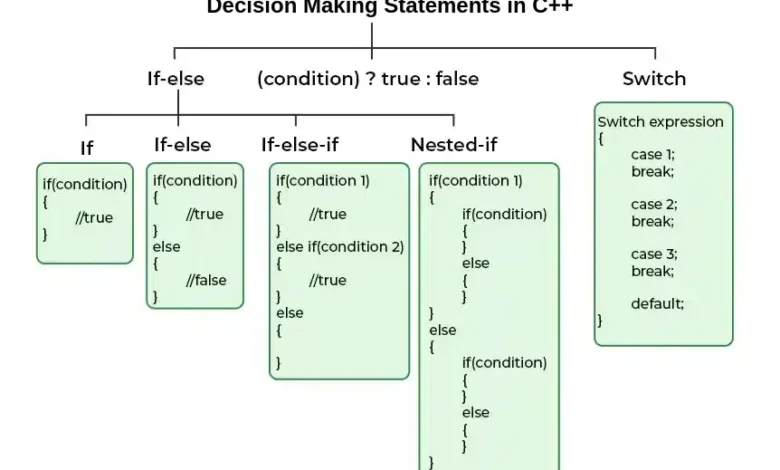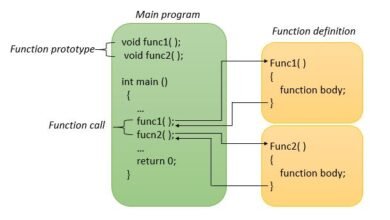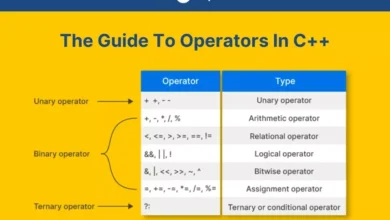Decision Making in C++

In C++, the following decision-making statements are available:

1. if Statement
In C++, the if statement is the simplest decision-making statement. It allows the execution of a block of code if the given condition is true. The body of the if statement is executed only if the given condition is true.
C++
#include <iostream>
using namespace std;
int main() {
int age = 19;
// Check if age is greater than 18 fo
// vote eligiblity
if (age > 18) {
cout << "allowed to vote";
}
return 0;
}
allowed to vote
We can skip to write curly brasses if there is only line statement inside the curly brasses.
C++
#include <iostream>
using namespace std;
int main() {
int age = 19;
if (age > 18)
cout << "allowed to vote";
return 0;
}
allowed to vote
Flowchart:

2. if-else Statement
The if else is adecision-making statement allows us to make a decision based on the evaluation of a given condition. If the given condition evaluates to true then the code inside the ‘if’ block is executed and in case the condition is false, the code inside the ‘else’ block is executed.
C++
#include <iostream>
using namespace std;
int main() {
int n = 5;
// Using if-else to determine if the number is positive
// or non positive
if (n > 0) {
cout << "number is positive.";
}
else {
cout << "number is non-positive.";
}
return 0;
}
number is positive.
Flowchart:

3. if else if Ladder
The if else if Ladder statements allow us to include additional situations after the preliminary if condition. The ‘else if’ condition is checked only if the above condition is not true, and the `else` is the statement that will be executed if none of the above conditions is true. If some condition is true, then not only the associated block is executed.
C++
#include <iostream>
using namespace std;
int main() {
int age = 18;
// if this condition is true child is printed
if (age < 13) {
cout << "child";
}
// if above above if statement is not true then we check
// this else if condition if it evalutes to true print
// growing age
else if (age >= 1 and age <= 18) {
cout << "Growing stage";
}
// if none of above condition is true print adult
else {
cout << "adult";
}
return 0;
}
Flowchart:

4. Nested if else
The nested if else statementcontains an ‘if’ statement inside another ‘if’ statement. This structure lets in more complex selection-making by way of comparing multiple conditions. In this type of statement, multiple conditions are checked, and then the body of the last if statement is executed.
C++
#include <iostream>
using namespace std;
int main() {
int n = 44;
// to check if n is positive
if (n > 0) {
// to check if the positive n is even or odd
if (n % 2 == 0) {
cout << "positive and even number";
}
else {
cout << "positive and odd number";
}
}
// to check if the n is 0
else if (n == 0) {
cout << "the number is zero";
}
// to check if the n is negative
else {
cout << "the number is negative";
}
return 0;
}
positive and even number
Flowchart:

5. Switch Statement
In C++, the switch statement is used when multiple situations need to be evaluated primarily based on the value of a variable or an expression. switch statement acts as an alternative to multiple if statements or if-else ladder and has a cleaner structure and it is easy for handling multiple conditions.
C++
#include <iostream>
using namespace std;
int main() {
char c = 'B';
switch (c) {
// if the input character is A then print GFG
case 'A':
cout << "GFG";
break;
// if the input character is B then print
// GeeksforGeeks
case 'B':
cout << "GeeksforGeeks";
break;
default:
// if the input character is invalid then print
// invalid input
cout << "invalid input";
}
return 0;
}
GeeksforGeeks
Flowchart:

6. Ternary Operator ( ? : )
The conditional operator is also known as a ternary operator. It is used to write conditional operations provided by C++. The ‘?’ operator first checks the given condition, if the condition is true then the first expression is executed otherwise the second expression is executed. It is an alternative to an if-else condition in C++.
C++
expression ? statement_1 : statement_2;
Example:
C++
#include <iostream>
using namespace std;
int main() {
int num1 = 10, num2 = 40;
int max;
// if the condition is true then num1 will be printed
// else num2 will printed
max = (num1 > num2) ? num1 : num2;
cout << max;
return 0;
}
40



